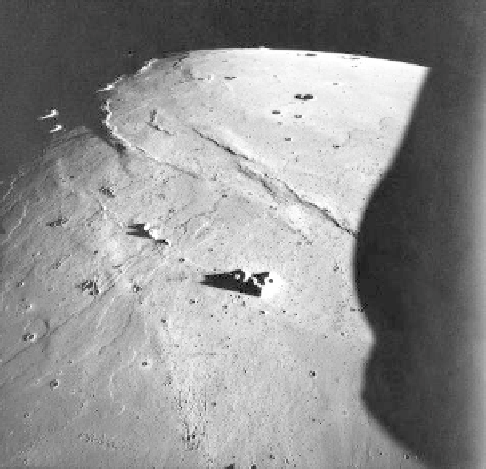Geology Reference
In-Depth Information
Figure 4.30. A view across Mare Imbrium showing lobate lava
ows,
some of which are inferred to have
flowed 1200 km from their
source; the
flows seen here are estimated to be only 10
Figure 4.31. The volcanic Aristarchus Plateau (the 40 km in
diameter impact crater Aristarchus is on the left) is the source for
Schröter
65m thick,
suggesting extremely low viscosity at the time of their emplacement
(NASA AS 15
-
s Valley, the large sinuous rille extending toward the right
side of the image and emptying into Oceanus Procellarum (NASA
AS 15
'
-
1555).
-
2611).
suggestions that they are ancient channels carved by
water or cut by silicic ash
ows, or that they are remnants
of lava channels or lava tubes.
When the Apollo samples showed a lack of evidence for
flowing water and extensive silicic materials on the Moon,
the ideas involving lava channels and lava tubes were
quickly accepted. As noted in
Section 3.2
, these volcanic
flow features are common in basalt
flows and are effective
conduits for transporting lavas to the advancing
ow
front. Tubes can either form directly in flows or develop
from channels that become roofed, either completely or in
segments. Once the molten lava has drained, lava tube
roofs often collapse (
Fig. 4.32
), leaving a series of dis-
continuous depressions. Thus, the observations that many
sinuous rilles include discontinuous segments is consis-
tent with their being lava channels/tubes. For example,
parts of the Hadley Rille, site of the Apollo 15 landing
(
Fig. 4.33
), appear to include roofed segments. Views of
the wall of the rille taken by the astronauts show that the
basalts consist of multiple lava
ows (
Fig. 4.34
) charac-
teristic of the types of eruptions in which lava channels
and tubes commonly form.
The margins of some mare regions show distinctive
benches where the lava is in contact with hills or
Figure 4.32. A high-resolution image of two collapse features
considered to be
into a lava tube; the image was taken in
early morning light (sun shining from right to left) by the Lunar
Reconnaissance Orbiter camera and covers an area ~200m across
(NASA/GSFC/Arizona State University).
“
skylights
”
largest, Schröter
'
s Valley (
Fig. 4.31
), was discovered tele-
scopically in the 1700s near Aristarchus crater. Lunar
Orbiter images (
Fig. 4.9
) stimulated a great deal of inter-
est
in sinuous rilles and their origin. Ideas included





